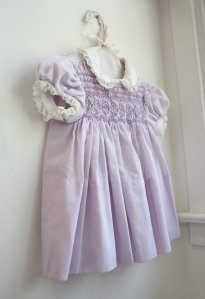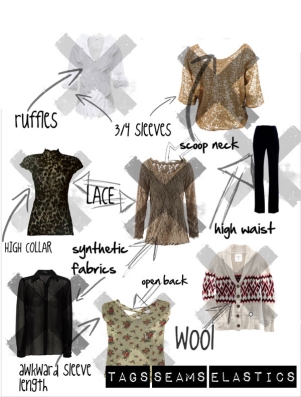Tactile Defensiveness
by musingsofanaspie, musingsofanaspie.comDecember 6th 2012
Polly Flinders was the bane of my childhood. I hated her with a passion. Why? Because she made dresses like this that were all the rage for little girls in the seventies:

For a four-year-old with tactile defensiveness, that dress was an instrument of torture. I can still feel the exposed elastic biting into my upper arm, the scratchy lace prickling my skin, the rasp of the tag on the back of my neck, the smocking bunching up across my chest.
Thanks to Polly Flinders and her ilk, I was branded a tomboy early in life. Not because I didn’t like dresses, per se. The way clothing feels is ten times more important to me than how it looks and “boyish” clothes (jeans, plain cotton shirts) were more comfortable.
I still shop for clothing based on feel first and look second. Where a lot of women see exciting new outfits, I see this:

Clothes shopping is a matter of eliminating the things I know will be too uncomfortable then choosing what I like from the remaining options. If there are any.
When I do find something I like–and by like, I mean something that’s comfortable–I tend to buy it in multiples. I have a rainbow of v-neck t-shirts and long sleeve tees, all exactly the same brand, style, material and cut. Last weekend, I found a soft comfy sweater at Old Navy and bought it in three different colors.
When I like something, I’ll wear it until it literally falls apart. The few things I really love–my favorite pair of jeans, my softest t-shirt–I put on as soon as they come out of the wash. They rarely get hung up in the closet.
That isn’t to say that I live in tees and jeans. I have some dressier clothes that are comfortable. I try to dress both comfortably and appropriately for the situation. You’re just not going to find me greeting my husband at the door in pearls and heels like June Cleaver.
Complicated and Delicate
My defensive shopping strategy, my intense dislike of Polly Flinders and many of my behavior quirks are a result of tactile defensiveness. Of all the sensory issues associated with ASD, this is the one that is most pervasive for me.
Tactile defensiveness (or tactile sensitivities, if you prefer) takes many forms, but the basic idea is that it causes a negative reaction to a tactile stimulus that is generally considered nonirritating by neurotypical people. The “nonirritating” tactile stimuli that irritate me include: seams (especially in socks!), tags, ruffles, lace, synthetics, wool, tags, tight/high waists, exposed elastics, stitching that I can feel against my skin, collars that are too high, collars that are too open, tags, shirts that are too loose or formless, and sleeves that are anything other than standard short or long sleeve length.
Did I mention tags?
The first thing I do when I buy a new shirt is cut the tag out. Unless The Scientist gets to it first. Last weekend I was about to cut the tag out of one my new sweaters when he took it away from me and went to get his penknife. I have a history of being so eager to get every little bit of the tag out of a shirt that I accidentally cut the shirt. The Scientist then has to listen to me berating myself for ruining a new shirt, so when the task looks complicated, he sometimes takes matters into his own hands.
As he was carefully trimming the last bits of stitching away, I bounced over to ask him why it was taking so long and without looking up from his work, he said, “It’s complicated and delicate. Like your feelings.”
Awwww.
And so true. My relationship with clothing has always been complicated. I have a lot of frustration and shame connected to my clothing preferences, mostly because I avoid clothes that are considered more stereotypically feminine. This was a big problem growing up. Shopping for dress-up clothes was a battle that both my mother and I dreaded. Still, no matter how much I protested, I was expected to dress “like a girl” on special occasions. The rest of the time, I defiantly clung to my worn bell-bottom pants and cotton polo shirts.
The Root of the Problem: Light Touch
The general theory of tactile defensiveness is that the light touch receptors in the skin are overly sensitive, triggering a “fight or flight” response, that causes the sufferer to perceive certain types of touch as threatening.
The first part rings true for me. I’m definitely oversensitive to light touch. The second part? Not so much. I have more of a “get the hell away from me” response. I don’t feel threatened by a lace collar. I don’t feel my heart begin to race or my palms sweat. Some types of sensory overload do provoke a fight or flight response in me, but when it comes to tactile sensitivities, the unwanted stimulus just irritates the hell out of me, to the point that I can’t stop thinking about anything other than making it go away.
I do know that others have much more severe tactile sensitivities than I do, so perhaps some people experience a response on the level of fight or flight. (If anyone who does can address this in the comments, that would be excellent.)
Deep Touch: The Kind Aspies Crave
Contrary to popular belief that aspies don’t want to be touched at all, many aspies like and seek out deep pressure touch. This is definitely true for me. I love the feel of heavy blankets, snug clothing (Under Armour!), and falling asleep with my husband spooned against me.
As a kid, I liked to pull my beanbag chair on top of me while I watched TV. I also liked to get my sister to lie down on me, a short-lived trick that stopped the day I told my older cousins about it and they made fun of me.
Occupational therapists recommend things like weighted blankets and lap pads to help children with tactile sensitivities get the pressure they crave. I’ve also read a lot of parents’ stories about children squeezing themselves into crevices between furniture, which is probably another way of getting a full body squeeze. I do something similar on trains and airplanes, slouching in my seat and wedging my knees against the seat in front of me.
Beyond Clothing
My tactile sensitivities have led to dozens of little quirks, most of which started in childhood. I’ve never liked the feeling of water spraying on my face (oddly, I’m fine with having my face underwater). If I’m eating something messy with my fingers, I clean them on a napkin between every bite. When my skin gets too cold, it itches worse than a case of poison ivy. If someone kisses me, I immediately wipe the little wet spot from my face.
These are all annoyances. I’ve been working around them or grudgingly tolerating them for decades. But as an adult with tactile sensitivities, I’ve also encountered an adult problem. To address it, I’m going to spend a couple of paragraphs talking about sex. If that makes you uncomfortable, you should skip down to the last section.
Tactile defensiveness can have a big impact on an intimate relationship. In my case, at times it makes me shrink away from my husband’s touch. Light touching–the kind often associated with seduction and sensuality–makes me tense up and pull away. It’s not so much irritating (like uncomfortable clothing) as it is overstimulating. Imagine being tickled in your most ticklish spot. My reflexive response is to break contact as quickly as possible.
For years, my aversion to sensual touching was the source of much frustration for both of us. My husband didn’t understand why I was randomly rejecting him. And it wasn’t a polite, “not tonight, dear, I have a headache” rejection. It was a very literal, “don’t touch me” often muttered as I shoved his hand away. Unfortunately, I had no explanation for why I disliked being touched at certain times or in specific ways. If I couldn’t explain it to myself, how I could explain it to him?
While I have a better understanding of my touch sensitivities now thanks to reading about Asperger’s, I don’t think I’ll ever enjoy light touching. On the positive side, many types of sexual touching and contact fall into the realm of deep pressure, meaning that it’s possible to have a rewarding sex life even if you suffer from tactile defensiveness. It may require some patience and communication, as well as a bit of research and experimenting, but it’s definitely possible.
Was I Supposed to Outgrow This?
In researching tactile sensitivities, I found a few occupational therapists who stated that most children outgrow their tactile defensiveness. Perhaps the children who get the recommended intensive early therapy do. I clearly haven’t, and judging from the postings on ASD forums, neither have many other adults.
There is little therapeutic information available for adults with tactile defensiveness. Once you’re past the age when playing with Play-doh is appropriate, I guess you’re supposed to be old enough to suck it up and deal with it.
As with so many other aspects of ASD, the experts seem to forget that autistic children grow up to be autistic adults. When that happens, the same sensitivities that kept us from finger painting affect our marriages and our parenting abilities. While I’ve seen some literature acknowledging that this problem exists, there is frustratingly little that addresses what we can do about it.
———————
*Polly Flinders is actually a character in a British nursery rhyme who had the misfortune of having her name co-opted by Bayliss Brothers, the company who made the dresses. Sorry, Polly, I guess I don’t really hate you after all, just your horrible namesake dresses.
Original Page: http://pocket.co/sh_jl
Shared from Pocket
Comments
Post a Comment